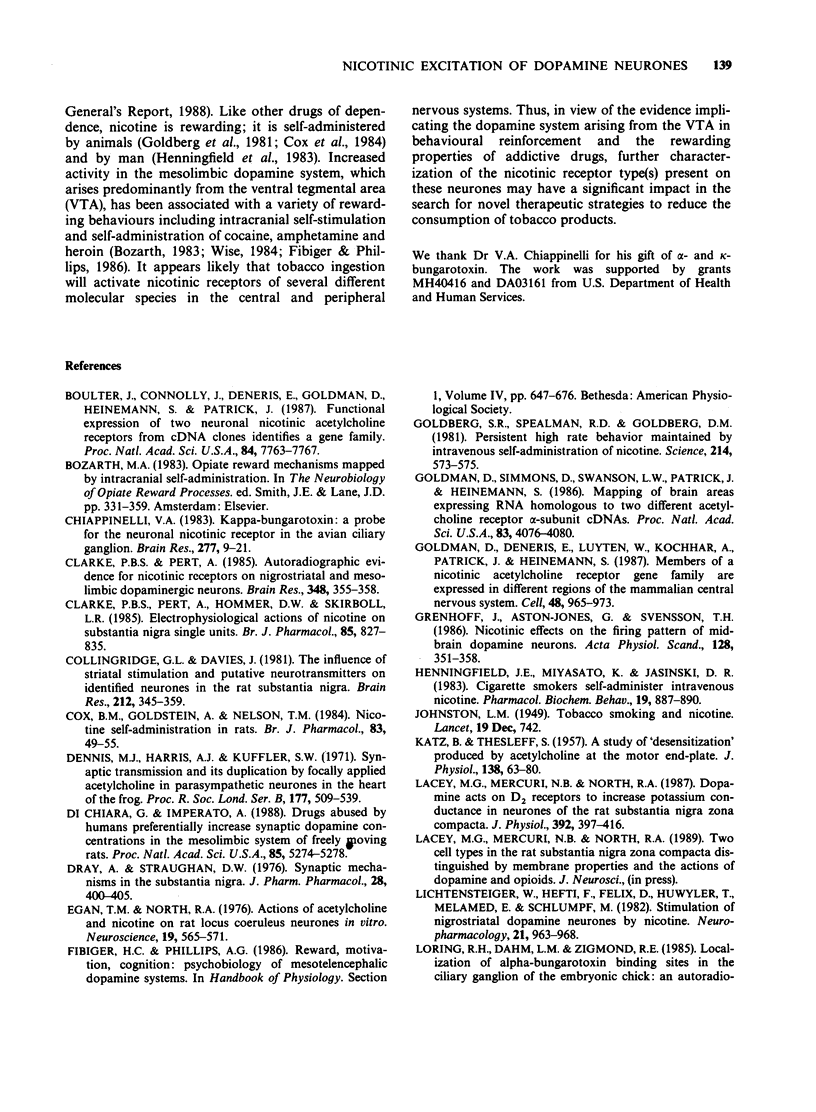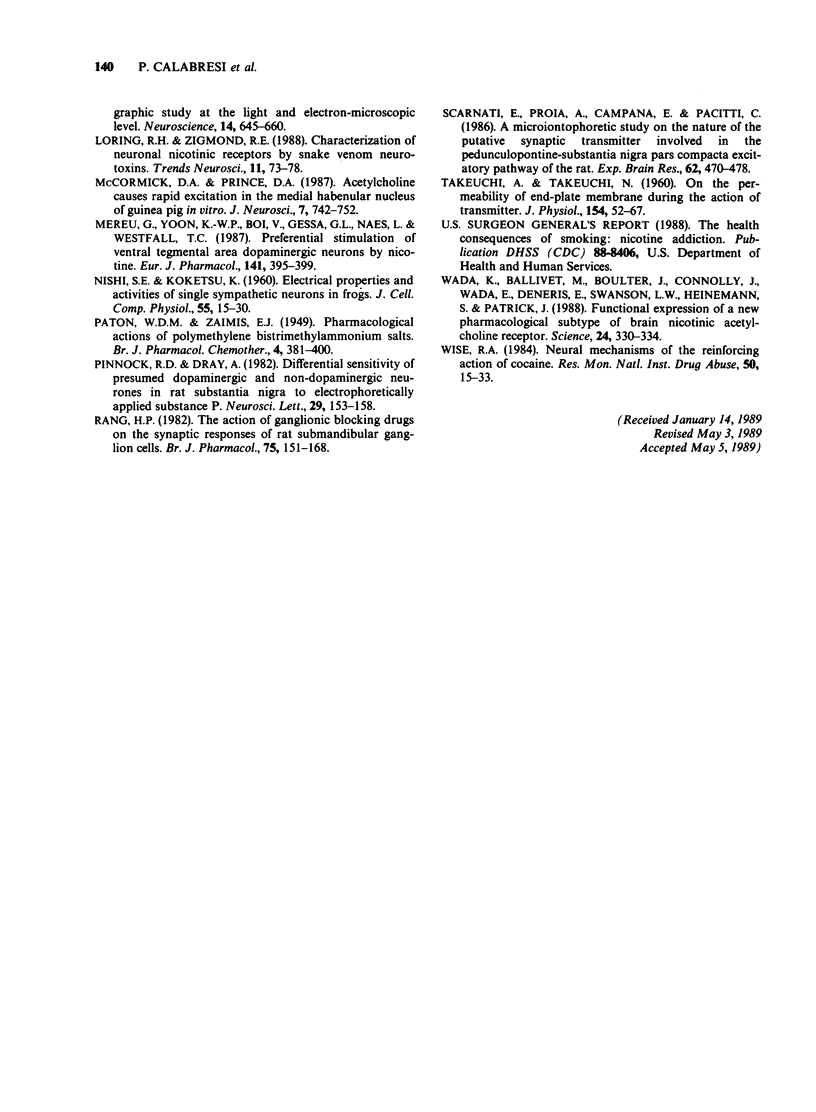Abstract
1. Intracellular recordings were made from presumed dopamine-containing neurones in the ventral tegmental area (VTA) in rat brain slices. 2. Nicotine (10-100 microM) and acetylcholine (ACh) depolarized the neurones. The depolarization caused by ACh was typically biphasic; both components were increased by neostigmine (0.1-10 microM), but only the slower component was blocked by scopolamine (1-10 microM). 3. The nicotinic action of ACh, studied in the presence of neostigmine and scopolamine, persisted in the presence of tetrodotoxin (1 microM) and cobalt (2-5 mM). 4. ACh or carbachol (30 microM) caused inward currents in neurones voltage-clamped near the resting potential. These currents reversed polarity at around -4 mV, were blocked by hexamethonium (1-100 microM) in a voltage-dependent manner, and showed desensitization with prolonged or repeated agonist applications. 5. Depolarizations caused by ACh and carbachol were reduced in slices pretreated with kappa-bungarotoxin, but were not changed by alpha-bungarotoxin. 6. These responses to ACh and nicotine resemble those previously described on autonomic ganglion cells. The direct action on VTA neurones may contribute to the positive reinforcement associated with nicotine consumption.
Full text
PDF





Selected References
These references are in PubMed. This may not be the complete list of references from this article.
- Boulter J., Connolly J., Deneris E., Goldman D., Heinemann S., Patrick J. Functional expression of two neuronal nicotinic acetylcholine receptors from cDNA clones identifies a gene family. Proc Natl Acad Sci U S A. 1987 Nov;84(21):7763–7767. doi: 10.1073/pnas.84.21.7763. [DOI] [PMC free article] [PubMed] [Google Scholar]
- Chiappinelli V. A. Kappa-bungarotoxin: a probe for the neuronal nicotinic receptor in the avian ciliary ganglion. Brain Res. 1983 Oct 24;277(1):9–22. doi: 10.1016/0006-8993(83)90902-2. [DOI] [PubMed] [Google Scholar]
- Clarke P. B., Hommer D. W., Pert A., Skirboll L. R. Electrophysiological actions of nicotine on substantia nigra single units. Br J Pharmacol. 1985 Aug;85(4):827–835. doi: 10.1111/j.1476-5381.1985.tb11081.x. [DOI] [PMC free article] [PubMed] [Google Scholar]
- Clarke P. B., Pert A. Autoradiographic evidence for nicotine receptors on nigrostriatal and mesolimbic dopaminergic neurons. Brain Res. 1985 Dec 2;348(2):355–358. doi: 10.1016/0006-8993(85)90456-1. [DOI] [PubMed] [Google Scholar]
- Collingridge G. L., Davies J. The influence of striatal stimulation and putative neurotransmitters on identified neurones in the rat substantia nigra. Brain Res. 1981 May 18;212(2):345–359. doi: 10.1016/0006-8993(81)90467-4. [DOI] [PubMed] [Google Scholar]
- Cox B. M., Goldstein A., Nelson W. T. Nicotine self-administration in rats. Br J Pharmacol. 1984 Sep;83(1):49–55. doi: 10.1111/j.1476-5381.1984.tb10118.x. [DOI] [PMC free article] [PubMed] [Google Scholar]
- Dennis M. J., Harris A. J., Kuffler S. W. Synaptic transmission and its duplication by focally applied acetylcholine in parasympathetic neurons in the heart of the frog. Proc R Soc Lond B Biol Sci. 1971 Apr 27;177(1049):509–539. doi: 10.1098/rspb.1971.0045. [DOI] [PubMed] [Google Scholar]
- Di Chiara G., Imperato A. Drugs abused by humans preferentially increase synaptic dopamine concentrations in the mesolimbic system of freely moving rats. Proc Natl Acad Sci U S A. 1988 Jul;85(14):5274–5278. doi: 10.1073/pnas.85.14.5274. [DOI] [PMC free article] [PubMed] [Google Scholar]
- Dray A., Straughan D. W. Synaptic mechanisms in the substantia nigra. J Pharm Pharmacol. 1976 Apr;28(4 Suppl):400–405. doi: 10.1111/j.2042-7158.1976.tb04187.x. [DOI] [PubMed] [Google Scholar]
- Egan T. M., North R. A. Actions of acetylcholine and nicotine on rat locus coeruleus neurons in vitro. Neuroscience. 1986 Oct;19(2):565–571. doi: 10.1016/0306-4522(86)90281-2. [DOI] [PubMed] [Google Scholar]
- Goldberg S. R., Spealman R. D., Goldberg D. M. Persistent behavior at high rates maintained by intravenous self-administration of nicotine. Science. 1981 Oct 30;214(4520):573–575. doi: 10.1126/science.7291998. [DOI] [PubMed] [Google Scholar]
- Goldman D., Deneris E., Luyten W., Kochhar A., Patrick J., Heinemann S. Members of a nicotinic acetylcholine receptor gene family are expressed in different regions of the mammalian central nervous system. Cell. 1987 Mar 27;48(6):965–973. doi: 10.1016/0092-8674(87)90705-7. [DOI] [PubMed] [Google Scholar]
- Goldman D., Simmons D., Swanson L. W., Patrick J., Heinemann S. Mapping of brain areas expressing RNA homologous to two different acetylcholine receptor alpha-subunit cDNAs. Proc Natl Acad Sci U S A. 1986 Jun;83(11):4076–4080. doi: 10.1073/pnas.83.11.4076. [DOI] [PMC free article] [PubMed] [Google Scholar]
- Grenhoff J., Aston-Jones G., Svensson T. H. Nicotinic effects on the firing pattern of midbrain dopamine neurons. Acta Physiol Scand. 1986 Nov;128(3):351–358. doi: 10.1111/j.1748-1716.1986.tb07988.x. [DOI] [PubMed] [Google Scholar]
- Henningfield J. E., Miyasato K., Jasinski D. R. Cigarette smokers self-administer intravenous nicotine. Pharmacol Biochem Behav. 1983 Nov;19(5):887–890. doi: 10.1016/0091-3057(83)90099-0. [DOI] [PubMed] [Google Scholar]
- KATZ B., THESLEFF S. A study of the desensitization produced by acetylcholine at the motor end-plate. J Physiol. 1957 Aug 29;138(1):63–80. doi: 10.1113/jphysiol.1957.sp005838. [DOI] [PMC free article] [PubMed] [Google Scholar]
- Lacey M. G., Mercuri N. B., North R. A. Dopamine acts on D2 receptors to increase potassium conductance in neurones of the rat substantia nigra zona compacta. J Physiol. 1987 Nov;392:397–416. doi: 10.1113/jphysiol.1987.sp016787. [DOI] [PMC free article] [PubMed] [Google Scholar]
- Lichtensteiger W., Hefti F., Felix D., Huwyler T., Melamed E., Schlumpf M. Stimulation of nigrostriatal dopamine neurones by nicotine. Neuropharmacology. 1982 Oct;21(10):963–968. doi: 10.1016/0028-3908(82)90107-1. [DOI] [PubMed] [Google Scholar]
- Loring R. H., Dahm L. M., Zigmond R. E. Localization of alpha-bungarotoxin binding sites in the ciliary ganglion of the embryonic chick: an autoradiographic study at the light and electron microscopic level. Neuroscience. 1985 Feb;14(2):645–660. doi: 10.1016/0306-4522(85)90316-1. [DOI] [PubMed] [Google Scholar]
- Loring R. H., Zigmond R. E. Characterization of neuronal nicotinic receptors by snake venom neurotoxins. Trends Neurosci. 1988 Feb;11(2):73–78. doi: 10.1016/0166-2236(88)90168-3. [DOI] [PubMed] [Google Scholar]
- McCormick D. A., Prince D. A. Acetylcholine causes rapid nicotinic excitation in the medial habenular nucleus of guinea pig, in vitro. J Neurosci. 1987 Mar;7(3):742–752. doi: 10.1523/JNEUROSCI.07-03-00742.1987. [DOI] [PMC free article] [PubMed] [Google Scholar]
- Mereu G., Yoon K. W., Boi V., Gessa G. L., Naes L., Westfall T. C. Preferential stimulation of ventral tegmental area dopaminergic neurons by nicotine. Eur J Pharmacol. 1987 Sep 23;141(3):395–399. doi: 10.1016/0014-2999(87)90556-5. [DOI] [PubMed] [Google Scholar]
- NISHI S., KOKETSU K. Electrical properties and activities of single sympathetic neurons in frogs. J Cell Comp Physiol. 1960 Feb;55:15–30. doi: 10.1002/jcp.1030550104. [DOI] [PubMed] [Google Scholar]
- PATON W. D. M., ZAIMIS E. J. The pharmacological actions of polymethylene bistrimethyl-ammonium salts. Br J Pharmacol Chemother. 1949 Dec;4(4):381–400. doi: 10.1111/j.1476-5381.1949.tb00565.x. [DOI] [PMC free article] [PubMed] [Google Scholar]
- Pinnock R. D., Dray A. Differential sensitivity of presumed dopaminergic and non-dopaminergic neurones in rat substantia nigra to electrophoretically applied substance P. Neurosci Lett. 1982 Apr 16;29(2):153–158. doi: 10.1016/0304-3940(82)90345-7. [DOI] [PubMed] [Google Scholar]
- Rang H. P., Colquhoun D., Rang H. P. The action of ganglionic blocking drugs on the synaptic responses of rat submandibular ganglion cells. Br J Pharmacol. 1982 Jan;75(1):151–168. doi: 10.1111/j.1476-5381.1982.tb08768.x. [DOI] [PMC free article] [PubMed] [Google Scholar]
- Scarnati E., Proia A., Campana E., Pacitti C. A microiontophoretic study on the nature of the putative synaptic neurotransmitter involved in the pedunculopontine-substantia nigra pars compacta excitatory pathway of the rat. Exp Brain Res. 1986;62(3):470–478. doi: 10.1007/BF00236025. [DOI] [PubMed] [Google Scholar]
- TAKEUCHI A., TAKEUCHI N. On the permeability of end-plate membrane during the action of transmitter. J Physiol. 1960 Nov;154:52–67. doi: 10.1113/jphysiol.1960.sp006564. [DOI] [PMC free article] [PubMed] [Google Scholar]
- Wada K., Ballivet M., Boulter J., Connolly J., Wada E., Deneris E. S., Swanson L. W., Heinemann S., Patrick J. Functional expression of a new pharmacological subtype of brain nicotinic acetylcholine receptor. Science. 1988 Apr 15;240(4850):330–334. doi: 10.1126/science.2832952. [DOI] [PubMed] [Google Scholar]
- Wise R. A. Neural mechanisms of the reinforcing action of cocaine. NIDA Res Monogr. 1984;50:15–33. [PubMed] [Google Scholar]


